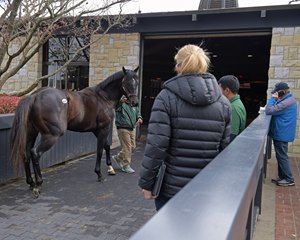Keeneland November Ends With Across the Board Gains


The Nov. 17 final session of the Keeneland November Breeding Stock Sale lasted just shy of four hours, but it was more than enough time to put the world's largest Thoroughbred auction house ahead on all figures over last year's numbers.
Through the 12 days of the November sale, Keeneland reported 2,667 horses sold for receipts of $200,139,400. The gross was a 1.2% gain over last year's balance of $197,851,300 for 2,644 horses. The sale average was up 0.3% to $75,043, and the median held steady at $25,000.
A total of 686 horses went unsold, representing an RNA rate of 20.5%. The figure was also down from 2018, when 810 horses did not attain their reserve for a rate of 23.5%.
In Sunday's 12th session, 117 head sold for $523,900, a 4.4% decline from 2018 when 119 horses changed hands for $547,900. The average was down 2.7% to $4,478, and the median declined 12% to $2,200. The RNA rate was 27.8%.
The highest price Sunday went to Hip 4390, a $30,000 Scat Daddy mare named True to You consigned by Vinery Sales, agent. Bred in Florida by H & A Stables and Annie Scott out of the Yes It's True mare April True, 7-year-old True to You was purchased by Machmer Hall.
Hip 4281 was the highest-selling weanling of the session, purchased for $24,000 by Kristy McDermott, agent, from the consignment of Taylor Made Sales Agency. Bred in Kentucky by Warlock Stables, Barrett, Myrick, and Hansen, the Pontiff filly is out of the Midnight Lute mare Midnight Hope and is from the family of grade 1-placed Kelly's Humor.
"Like any market, you have an upper end and you've got a lower end," said Keeneland's director of sales operations, Geoffrey Russell, who attributed the dip in prices during the final sessions to both the cyclical nature of spending and the desire to cull those individuals that no longer fit a breeder's program. "The cost to keeping a horse in training on a horse farm or whatever, it's the same regardless if it's a million-dollar horse or a thousand-dollar horse. It's pure economics.
"I mean, people are going to say it's not worth buying that because the return on my investment isn't very good. People want to buy quality. We're talking to consignors this week, and everyone is making the same comment: 'We're selling these mares because we just want to be in this part of the market. Upper, upper middle, that's where we want to play. We do not want to be at the lower end.' So you're seeing it just drift. It runs in cycles. It just costs a lot of money to keep a horse. You've got to stop the meter and sell them."
While several sessions experienced a decline in figures, the November sale had several standout offerings. At the top end of the sale was champion Take Charge Brandi (Hip 111), who was purchased by Hill 'n' Dale at Xalapa during the Nov. 6 opening session. The mare, who was consigned by Hill 'n' Dale Sales Agency as agent for the Elevage Dispersal, was offered in foal to Triple Crown winner Justify .
The weanling market showed particular strength throughout the sale, with buyers and pinhookers bidding furiously for foals with standout physicals and deep pedigrees. Hip 1039 set the bar for the weanling market, selling to Larry Best's OXO Equine for $775,000 during the sale's third session. A daughter of Curlin out of the Giant's Causeway mare Fly to the Stars, the filly was bred in Kentucky by Peter Redekop BC and consigned by Indian Creek, agent. She is a half sister to grade 3 winner The Tabulator and stakes-placed runner Star Via Strada.
While mares and weanlings drove demand through the majority of the sale, horses of racing age enticed a different set of buyers to the grounds Nov. 12 and 13. The two days of racing prospects were topped by Hip 2761G, a 2-year-old Liam's Map colt consigned by Indian Creek, agent.
Entered in the supplemental catalog, Liam's Legend was bred in Kentucky by Mark Stansell out of the Cherokee Run mare Indian Legend. He was purchased by Khalid Mishref on a final bid of $325,000.
Bob Elliston, Keeneland's director of racing and sales, said the spending patterns of buyers during the sale were consistent with previous North American auctions this year. With demand for quality highly concentrated at the top, bringing the right horse to auction remains paramount if breeders and consignors wish to see the greatest return on investment.
"Geoffrey always says, 'You have got to have a good horse,'" said Elliston. "Let's be clear: If you've got a good horse covered with an in-demand sire, a young mare or a weanling by one of the young sires that have come to market recently, and this year for that matter, there's a lot of folks that want those kinds of horses.
"We had a good bit of depth up front. I think that's why we carry significant growth over last year in Book 1. As we got into Books 2, 3, and 4, we had a lot of good horses, but maybe we didn't have as deep a number of each of those horses in those sessions, relatively speaking, and I think that's why we had solid trade against last year, but we didn't carry that 15% growth. You've got to have a good horse. There's no question about that."
Ron Mitchell contributed to this report
